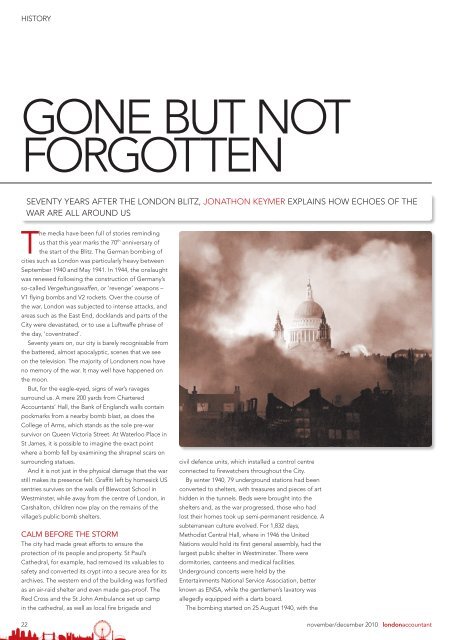HISTORYGONE BUT NOTFORGOTTENSEVENTY YEARS AFTER THE LONDON BLITZ, JONATHON KEYMER EXPLAINS HOW ECHOES OF THEWAR ARE ALL AROUND USThe media have been full of stories remindingus that this year marks the 70 th anniversary ofthe start of the Blitz. The German bombing ofcities such as London was particularly heavy betweenSeptember 1940 and May 1941. In 1944, the onslaughtwas renewed following the construction of Germany’sso-called Vergeltungswaffen, or ‘revenge’ weapons –V1 flying bombs and V2 rockets. Over the course ofthe war, London was subjected to intense attacks, andareas such as the East End, docklands and parts of theCity were devastated, or to use a Luftwaffe phrase ofthe day, ‘coventrated’.Seventy years on, our city is barely recognisable fromthe battered, almost apocalyptic, scenes that we seeon the television. The majority of Londoners now haveno memory of the war. It may well have happened onthe moon.But, for the eagle-eyed, signs of war’s ravagessurround us. A mere 200 yards from CharteredAccountants’ Hall, the Bank of England’s walls containpockmarks from a nearby bomb blast, as does theCollege of Arms, which stands as the sole pre-warsurvivor on Queen Victoria Street. At Waterloo Place inSt James, it is possible to imagine the exact pointwhere a bomb fell by examining the shrapnel scars onsurrounding statues.And it is not just in the physical damage that the warstill makes its presence felt. Graffiti left by homesick USsentries survives on the walls of Blewcoat School inWestminster, while away from the centre of London, inCarshalton, children now play on the remains of thevillage’s public bomb shelters.CALM BEFORE THE STORMThe city had made great efforts to ensure theprotection of its people and property. St Paul’sCathedral, for example, had removed its valuables tosafety and converted its crypt into a secure area for itsarchives. The western end of the building was fortifiedas an air-raid shelter and even made gas-proof. TheRed Cross and the St John Ambulance set up campin the cathedral, as well as local fire brigade and22civil defence units, which installed a control centreconnected to firewatchers throughout the City.By winter 1940, 79 underground stations had beenconverted to shelters, with treasures and pieces of arthidden in the tunnels. Beds were brought into theshelters and, as the war progressed, those who hadlost their homes took up semi-permanent residence. Asubterranean culture evolved. For 1,832 days,Methodist Central Hall, where in 1946 the UnitedNations would hold its first general assembly, had thelargest public shelter in Westminster. There weredormitories, canteens and medical facilities.Underground concerts were held by theEntertainments National Service Association, betterknown as ENSA, while the gentlemen’s lavatory wasallegedly equipped with a darts board.The bombing started on 25 August 1940, with thenovember/december 2010 <strong>londonaccountant</strong>
HISTORYContrary to popular belief, St Paul’s itself was hitseveral times. The high altar was destroyed,although its famous dome survivedfirst serious raid attacking the docks in earlySeptember. On 9 September, the Bank of Englandtelephone exchange was hit. Four days later,Buckingham Palace was bombed for the first of severaltimes, prompting Queen Elizabeth – later the QueenMother – to remark: ‘I’m glad we’ve been bombed.It makes me feel I can look the East End in the face.’Contrary to popular belief, St Paul’s itself was hitseveral times. The high altar was destroyed, althoughits famous dome survived.The night of 29 December was, for London, theworst of the war so far. The damage from that night’sraids constituted the largest single area of devastationin the country, stretching from Islington to the southside of the City. German incendiary bombs, which atone point were falling at a rate of 300 a minute,started up to 1,500 individual fires. Not for nothing isthe night sometimes referred to as the ‘Second GreatFire of London’.Many City workers are familiar with the largecrossroads outside the Bank of England and the RoyalExchange, which formed the focal point of the G20unrest of April 2009. Fewer may be aware that it wasonce known as the ‘Biggest Crater in London’ – theresult of a bomb penetrating the tarmac and liftingthe roof off Bank station ticket hall below. As the blastrushed down the escalators to the platforms below, itincinerated dozens of people, making it one of thebloodiest single attacks of the Blitz.The heaviest raid, however, was yet to come. On thenight of 10 May 1941, more than 500 aircraft attackedLondon, killing some 1,400 people. The roof ofWestminster Abbey collapsed and it is damage fromthat night that marks the walls of St Clement Danes onthe Strand. Visitors to the Temple Church can seedamage on the effigies caused by the molten lead thatfell from the roof while it burned.With the stresses and strains of our daily lives, it iseasy to forget that earth-shattering events once tookplace where we now live and work. But there is muchthat remains of London’s recent history for those whoknow where to look.Jonathon Keymer runs tours ofcentral London, paying particularattention to the areas affectedby the Blitz. All proceeds go tothe Soldiers, Sailors, Airmen andFamilies Association.For details, emailjonathon.keymer@icaew.com.For details of the Soldiers, Sailors,Airmen and Families Association,visit www.ssafa.org.ukTHE INSTITUTE AND THE WARSurprisingly, despite being in one of theworst-hit areas, Chartered Accountants’Hall survived the Blitz relativelyunscathed. The membership, however,participated in the war effort at home andoverseas.Of 13,000 members, 3,000 pledged full-timenational service: 475 lost their lives.In prisoner of war camps, captured charteredaccountants, alongside other professionals,formed groups to teach other inmates tradesthat they might follow after the war. As a result,many prisoners sat official institute papers andpassed the ACA course while ‘in the bag’.On the home front, the membership’scontribution was also notable. As recognitionof the importance of strong finances – Ciceroonce referred to money as the ‘sinews of war’– chartered accountancy had been designateda reserved occupation since the Great War.The war made it necessary for the completeindustrial and financial resources to bemobilised. As the prospect of war loomed,6,000 members responded to institutepresident CJG Palmour’s invitation that theyregister their skills for the war effort. Many werethen enlisted as senior advisers to governmentand industry. Others were appointed astemporary officers in the Army Service Corps oras assistant paymasters in the Royal Navy.Other challenges, less glamorous perhaps,but unique to the profession, manifestedthemselves during those dark days. Largescalebombing throughout the country, forexample, had a particular resonance forauditors. Publishing information in acompany’s accounts that disclosed thedamage caused to an organisation’s premisescould help the enemy determine theeffectiveness of his attacks. In August 1941,therefore, the institute’s council issuedpractising members with a letter suggestingalternative wording to be used on thebalance sheet of a company whose premiseshad been damaged.<strong>londonaccountant</strong> november/december 201023
















